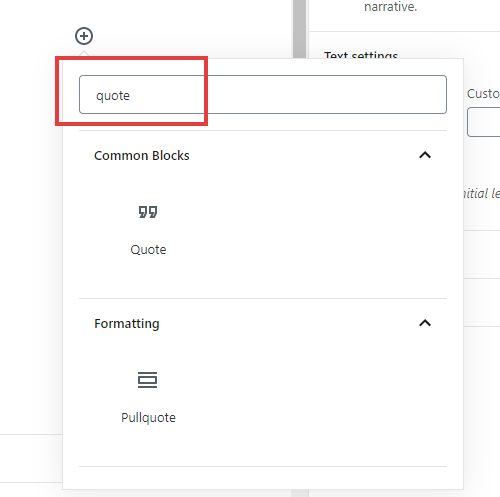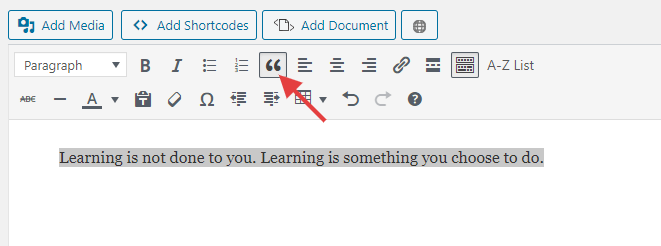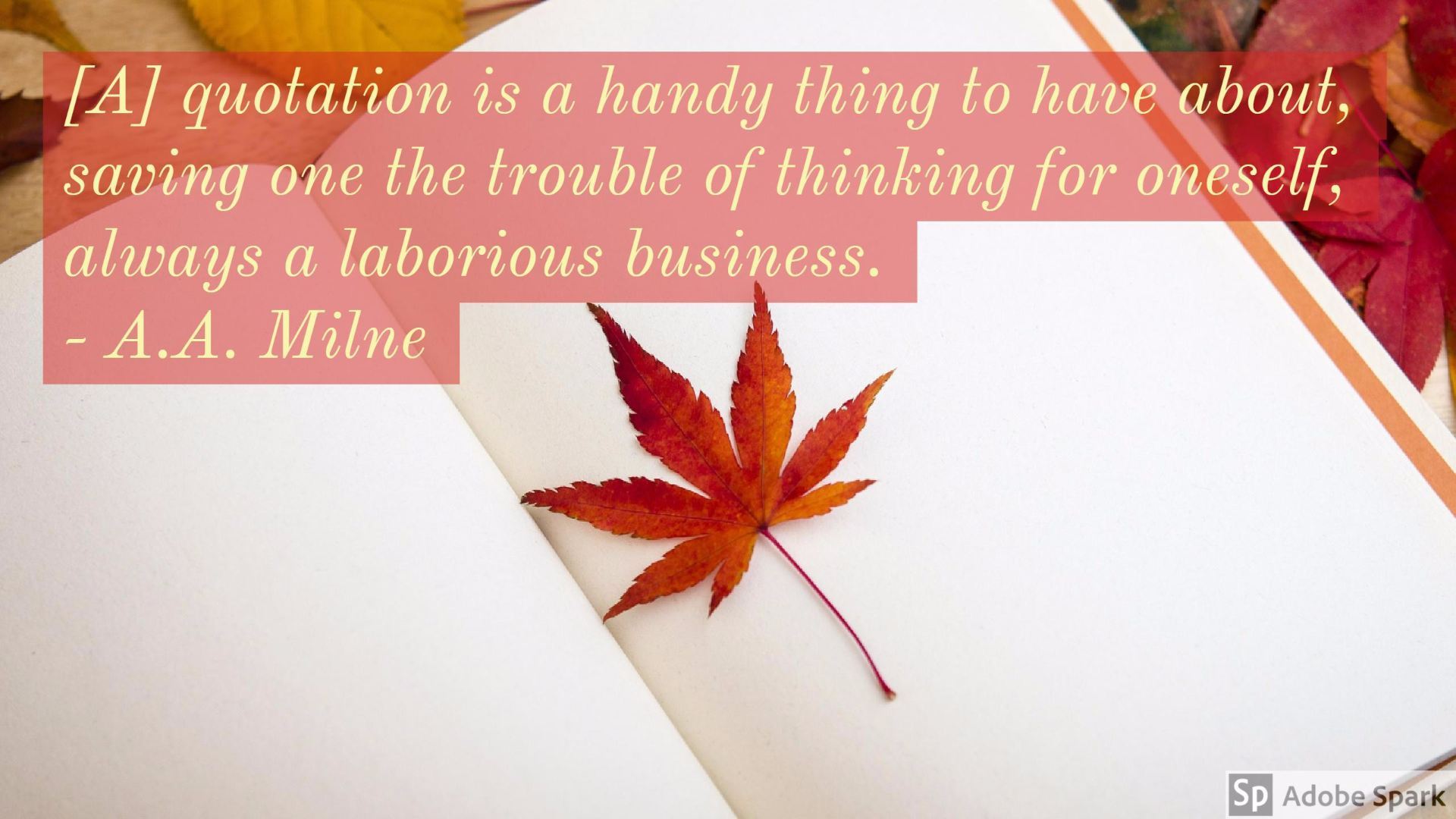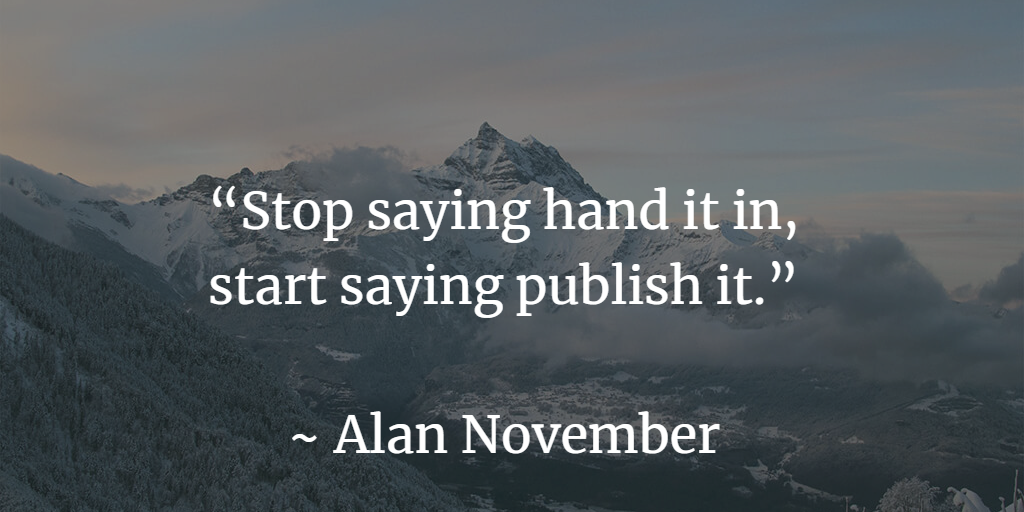How To Include Quote On Website Blog
If you're active on social media or enjoy reading blogs, you'll no doubt be aware of the popularity of quotes.
There's something about quotes that many people find inspiring, motivating, and shareworthy.
Perhaps they're a good pick-me-up when times get tough, or maybe they remind us of the deeper meaning behind our everyday routine. Sometimes quotes might offer a burst of insightful learning for the time poor.
Whatever the case, quotes can be powerful.
In this post we go through the advantages of adding quotes to your blog posts, how to add quotes using the block editor or classic editor, where to find quotes, and the etiquette of borrowing words from others. We'll also show you simple ways to create images to display your quotes.
Why Weave Quotes Into Blog Posts?
Here are six reasons why quotes might become a regular feature in your blog posts:
- You can back up your thoughts and make your writing more credible.
- Student voice can be incorporated into a blog post written by a teacher.
- You can provide alternative viewpoints or encourage readers to reflect.
- Quotes can help you begin or end your blog post with impact.
- The research involved in finding quality quotes is a solid learning experience.
- Quotes can make your posts easier to read as they break up the text.
How To Put A Quote In Your Post
You can just type your quote into a post and put it in quotation marks, but to really make it stand out and break up your text, try a quote block. Your words will display like this:
Learning is not done to you. Learning is something you choose to do.
― Seth Godin, Stop Stealing Dreams
Adding a quote is easy. If you're using the block editor (Gutenberg) in WordPress, Edublogs, or CampusPress, you use the Add Block button to add a quote block to your page. If you can't see the quote block, just type in quote in the search field.

The quote block comes with the standard editing options: alignment, bold, italicize, hyperlinks, and strikethrough.

If you press the button on the far left of the toolbar, you'll be able to choose between two block styles. Depending on your theme, you may have additional styles to choose from. Your theme determines how quotes are displayed.
If you're still using the classic WordPress editor, you can add a blockquote by following these instructions:
- Type the quote
- Highlight the words in your quote
- Click on the quotation mark icon in your toolbar

Where Can You Find Quotes?
You might already have some favorite quotes stored away that have never left you. You might do a Google search for articles on your topic and find quotes from others.
Otherwise, you may enjoy browsing an online collection of quotes, such as the following:
- GoodReads Quotes
- LitQuotes
- BrainyQuote
Quote Legalities And Etiquette
We know we can't just take images that we find online, and we certainly can't copy others' writing and publish it as our own. So, many people might wonder about using quotes.
It's fine to use quotes from others but there are a few things to be aware of:
- Make it obvious which words are your own, and which words belong to someone else by using quotation marks or block quotes.
- Make your quotes brief. There are no universal rules here. Some larger organizations have guidelines around how much of their work you can quote (e.g. Hubspot's rules are 75 words). If you're unsure or think you might be using too much of someone's article, contact them to ask permission. Never copy the whole post.
- Always include the person's name, and link to their site, article, or book if you can. Obviously, if you're quoting someone like Aristotle or Mother Teresa, hyperlinking may not be an option!
- If you're using blockquotes, the attribution could be before the quote, inside it, or below it.
- If you shorten a quote, use an ellipsis (…) in place of the missing words.
- If you're adding any words or corrections to the quote, use brackets.
Make Your Quotes More Visual
There are many online tools where you can turn your quote into writing on an image. These can make your blog posts look more visually appealing, and are great to share on social media too.
Here are just a few free online tools that might be useful for students or teachers:
Canva
Canva is a really popular tool to make all sorts of graphic designs and documents. The paid premium version of Canva is free for teachers and students.
Learn more about Canva in our guide for educators on The Edublogger.
Here is an example of a quote I made with Canva.

Adobe Spark
Similar to Canva, Adobe Spark is an online drag and drop tool that allows you to make social posts and graphics. Adobe Spark for Education gives students and teachers premium features for free.
Here is an example of a quote made with Adobe Spark:

Pablo And Remix
Pablo is a user-friendly web tool from Buffer (a social media scheduling tool). While Buffer is no longer updating Pablo, it seems to work well, and is fast and free. You simply add your text to a Creative Commons Zero image and save your work.
Buffer also has a free app for iOS and Android called Remix. The great thing about this app is it is completely free with no watermark or in-app purchases.
Here's an example made with Pablo:

Quozio
Quozio is a really simple tool that doesn't require any sign up, so it's ideal for young students to use. You simply add your text and choose your background before saving your image. Here's an example:

Note On Accessibility
Vision impaired visitors to your blog may be using assistive technology like screen readers to read the page out loud.
If you put words on an image, it's essential that you write the actual words from the quote in the alt text section. You'll find this in the Block Image settings on the right hand side of your screen.

If you're interested in learning more about accessibility, check out the complete guide on the CampusPress blog.
Five Ideas For Using Quotes In The Classroom
If you're an educator, there are many ways you can weave quotes into your blog or website.
- Quote young students: If you teach very young students, you could put the students' quotes about their learning in a different color on your blog. This makes it easier for them to go home and proudly share their blue/red/green writing with their parents.
- Explore a quote in a post: If you have student bloggers, why not have them choose a quote from a fellow student's blog post as a topic for a post of their own? They can explore the quote in detail and add their own thoughts and opinions.
- Posts full of quotes: You or your students could create blog posts that are a compilation of quotes. For example:
- If you were studying World War Two, you could put together a collection of important quotes from this time in history.
- If your class visited the museum, you could add quotes from all the students about their field trip.
- If you were studying a divisive topic, like animal testing or closing a local library, you could interview members of the community and include their quotes in the post.
- Quote library: You or your students could start your own library of interesting quotes as you come across them. You could add them to a Google Doc and then refer to them when writing blog posts in the future, or house them on a page on your blog.
- Quote of the day blog: Some people have a photo of the day blog. What about a blog where a quote is published each day? This could be a mix of quotes from members of the school community, or well known identities or historical figures.
Bringing in the voices of experts or giving your students a voice through the use of quotations could have a big impact. Why not consider ways that you and your students could integrate quotes into your blog posts?
We keep moving forward, opening up new doors and doing new things, because we're curious…and curiosity keeps leading us down new paths.
― Walt Disney Company
What Can You Add?
Do you use quotes in your blog posts? Share a favorite quote in a comment.
Or perhaps you can share a website to find quotes or tell us how you display quotes as images. We'd love to hear from you.
About Us
At CampusPress, we're experts in bringing innovative web solutions to schools, school districts, colleges, and universities through WordPress and our wide range of out-of-the-box and custom plugins and products.
In fact, our services in accessibility, security, hosting, support, along with an extensive suite of other tools, power millions of education websites, blog networks and portfolios. Learn more about our school website services or request info today!
How To Include Quote On Website Blog
Source: https://www.theedublogger.com/quotes/
Posted by: murphyotibitepar.blogspot.com

0 Response to "How To Include Quote On Website Blog"
Post a Comment